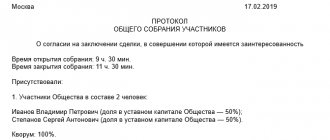An operation to forgive a debt represents the termination of the debtor’s obligation to the creditor, if this does not violate the rights of other persons in relation to the latter’s property (Article 415 of the Civil Code of the Russian Federation).
The creditor may express his decision to forgive the debt in a notice to the debtor. Another option is to enter into a bilateral agreement with him. This document should detail the conditions under which the debt is considered forgiven. It is also necessary to reflect during the execution of which contract and for what amount the debt was generated (the subject of the transaction). Therefore, the agreement should detail the following:
- conditions under which the debt is considered forgiven;
- details of the agreement on the basis of which the debt was formed, its amount (subject of the transaction);
- supporting documents (delivery note;
- act of acceptance and transfer of work performed (services rendered);
- Act of reconciliation.
Copies of the contract and other documents confirming the debt must be attached to the agreement.
How to apply for debt forgiveness between legal entities
Important!
Article 575 of the Civil Code of the Russian Federation prohibits the donation of assets between organizations, and therefore the debt forgiveness transaction must be formalized properly so as not to arouse suspicion from the tax inspectorate. The wording of the debt forgiveness agreement should be as clear and precise as possible.
The creditor has the right to forgive and write off the debt of the debtor organization on the basis of the provisions of Art. 415 of the Civil Code of the Russian Federation. The main thing is that the rights of the legal entity acting as a debtor are not infringed. If an organization objects to the debt being forgiven, its management notifies the creditor of such a decision.
Regarding the question of how to arrange debt forgiveness between legal entities, there are 2 options:
- Sending a written notice to the debtor about the amnesty of the obligations specified in the document
(in this case, the date of debt forgiveness is considered the day the debtor receives this notice). - Execution of a bilateral debt termination agreement
(supported by copies of contracts, initial forms and all other documents mentioned in the text of the agreement). Such a document must include the following information:
- the amount of debt that will be forgiven;
- subject of the transaction;
- absence of objections from the parties to the repayment of the debt;
- names of creditor and debtor organizations, details;
- circumstances and conditions under which the debt can be recognized as written off;
- details of the agreement between the parties, according to which one of the parties to the agreement incurred financial obligations of a credit nature;
- information about primary documentation proving the fact of the debt;
- an economic justification for the need for debt forgiveness, which would exclude the possibility of treating such a step as a donation transaction (the economic justification could be the provision of a discount on future supplies or the possibility of signing promising contracts).
In order for a debt forgiveness transaction between legal entities to be recognized as valid, it is necessary to draw up a reconciliation act between the parties to such an agreement, which would prove the veracity of information about the amount of the existing debt
. The lender must proceed as follows:
- draw up a reconciliation report with the debtor company;
- send the counterparty a notice of intention to forgive part of the debt or the entire debt;
- wait for a response from the counterparty in case he has any objections;
- document the transaction (form an agreement on debt forgiveness or draw up an additional agreement to the agreement on the provision of services, performance of work or supply of products).
Forgiveness and Giving
Under a gift agreement, one party gratuitously transfers or undertakes to transfer another thing into ownership or a property right to itself or to a third party, or releases or undertakes to release it from a property obligation to itself or to a third party (clause 1 of Article 572 of the Civil Code of the Russian Federation).
Let me remind you that donations between commercial organizations are prohibited. The exception is gifts worth no more than 3,000 rubles (Clause 1, Article 575 of the Civil Code of the Russian Federation). Thus, if a debt forgiveness transaction between two companies is qualified as a gift, the court will invalidate it.
Therefore, it is advisable to carry out the debt forgiveness procedure with a condition. For example, about the percentage of interest when repaying the principal amount of the loan. In this case, forgiveness of debt “with condition” is not identical to donation.
Help your business grow
Invaluable experience in solving current problems, answers to complex questions, specially selected latest information in the press for accountants and managers. Choose from our catalog >>
If you have a question, ask it here >>
Accounting and postings (how to arrange debt forgiveness between legal entities)
Due to the fact that the forgiven debt cannot be taken into account when calculating the tax base, permanent differences arise in accounting with permanent tax liabilities - these discrepancies should be reflected in DEBIT 99 and CREDIT 68 . When concluding a transaction to forgive the debt of a legal entity, the following entries can be used:
| Operation | DEBIT | CREDIT |
| Recording the fact of sale of finished products | 62 | 90.1 |
| Calculation of value added tax | 90.3 | 68 |
| Reflection of the write-off of the actual cost of the shipped batch of goods | 90.2 | 41 |
| Transfer by the debtor of part of the debt amount at the expense of the supplier | 51 | 62 |
| Partial/full repayment of debt upon concluding a debt forgiveness agreement | 91.2 | 62 |
| Permanent tax liability based on a certificate-calculation | 99 | 68 |
A debt from a counterparty may arise not only due to late payment for shipped goods, but also as a result of obtaining a loan. In this case, the lender is obliged to keep separate records of the loan itself and the interest on it. At the stage of drawing up an agreement on the forgiveness of such a debt, it is necessary to provide a clause that would explain what amounts this agreement applies to - exclusively to borrowed funds or also to interest accrued on the loan.
Important!
The lender can initiate an agreement to forgive not the loan debt itself, but only the interest and penalties on it.
Here's what you need to remember about loan forgiveness:
- the forgiven debt in the amount of interest on the loan is not recognized as an expense transaction (see Letter of the Ministry of Finance of the Russian Federation dated December 31, 2008 No. 03-03-06/1/728), however, in accounting such an operation entails the appearance of expenses according to PBU 18/02;
- an entry is made in the accounting records DEBIT 91.2 CREDIT 76 for the amount of interest on the loan being written off;
- Since loans are not subject to VAT, there are no tax consequences for this type of tax when the interest debt is forgiven.
- After signing the debt forgiveness agreement, the accountant makes the following entries in the accounting registers:
| Operation | DEBIT | CREDIT |
| Reflection of the fact of issuance of borrowed funds | 58.3 | 51 |
| Monthly posting of interest accrual on the outstanding amount of the loan | 76 | 91.1 |
| Repayment of principal | 51 | 58.3 |
| Cancellation of loan interest specified in the debt forgiveness agreement | 91.2 | 76 |
| Fixation of permanent tax liability | 99 | 68 |
Debt forgiveness. VAT and other difficulties
In practice, it often happens this way: one company forgives another part of the debt for goods shipped (work performed, services rendered). However, reflecting this fact in accounting and tax accounting is not as simple as it seems at first glance.
The Tax Code of the Russian Federation does not contain such a concept as “debt forgiveness”. In fact, when a debt is forgiven, accounts receivable from the seller (creditor) are written off, and accounts payable are written off from the buyer (debtor). income tax...
Financiers equate debt forgiveness to a gratuitous transfer (see letter of the Ministry of Finance of Russia dated July 12, 2006 No. 03-03-04/1/579). The cost of gratuitously transferred valuables is not taken into account as part of tax expenses (clause 16 of article 270 of the Tax Code of the Russian Federation). True, the transferring party also does not receive income from such a transaction (Article 250 of the Tax Code of the Russian Federation).
This means that if the debt for shipped goods (work performed, services rendered) is forgiven, then the sales revenue previously reflected in tax accounting should not be taken into account as part of tax income. Similarly, it is necessary to exclude from tax expenses the cost of goods shipped (work performed, services rendered).
In our opinion, in such a situation, the accounting department of the selling company should act this way. On the day the debt is forgiven, accounting must recognize in tax accounting:
– non-operating expense in the amount of forgiven “receivables”;
– non-operating income in the amount of the cost of goods (work, services), previously recognized as part of sales expenses.
...and VAT
The gratuitous transfer of goods (performance of work, provision of services) is subject to VAT (subclause 1, clause 1, article 146 of the Tax Code of the Russian Federation).
However, in our case (when the debt is forgiven), VAT was already charged upon shipment of goods (work, services). There should be no repeated taxation, therefore, on the date of signing the debt forgiveness document, the seller has already actually fulfilled his VAT obligations. Consequently, there is no need to make changes to the sales book for the tax period in which the goods (work, services) were sold.
The only question that arises is: can the amount of previously accrued VAT on sales proceeds be taken into account as expenses when taxing profits? Theoretically, this is quite possible. Indeed, in this situation, it turns out that VAT was actually paid at the expense of the seller’s own funds. And if so, this amount can be taken into account in expenses on the basis of subparagraph 1 of paragraph 1 of Article 264 or subparagraph 20 of paragraph 1 of Article 265 of the Tax Code of the Russian Federation.
However, in practice, tax authorities are categorically against this. They believe that such an expense is associated with a gratuitous transfer and cannot be taken into account when taxing profits. Therefore, if you are not ready to argue, in order to minimize fiscal risks, it is better not to recognize such an expense in tax accounting.
Example
CJSC Rassvet is engaged in the production of canned fish, which it then sells to wholesale buyers.
On June 15, 2008, Rassvet sold a batch of canned sturgeon - 10,000 cans - to the buyer, Zakat LLC.
The selling price of one can of canned food (excluding VAT) is 100 rubles. per jar. Therefore, the total price of the lot without VAT is 1,000,000 rubles. (10,000 cans × 100 rubles). The cost of one can of canned food is 50 rubles. Consequently, the cost of the shipped batch of goods is 500,000 rubles. (10,000 cans × 500 rub.)
Canned sturgeon fish are subject to VAT at a rate of 18 percent. This means that the amount of VAT that ZAO Rassvet presented to the buyer was:
10,000 cans × 100 rub. × 18% = 180,000 rub.
Thus, the total cost of the shipped batch of finished products (including VAT) is 1,180,000 rubles. (1,000,000 + 180,000).
The accounting department of Rassvet made the following entries on June 15, 2008:
DEBIT 62 CREDIT 90
– 1,180,000 rub. – revenue from the sale of a batch of finished products is reflected;
DEBIT 90 CREDIT 68 subaccount “VAT calculations”
– 180,000 rub. – VAT is charged on sales proceeds;
DEBIT 90 CREDIT 43
– 500,000 rub. – the cost of finished products is written off.
Payment from the buyer was not received within the period established by the contract. In order not to completely lose payment, the management of Rassvet CJSC decided to forgive half of the debt to the buyer - 590,000 rubles. (RUB 1,180,000: 2). On August 19, 2008, the director of Rassvet CJSC signed the corresponding notice and sent it by fax to Zakat LLC.
On the date of signing the notice, the accounting department of Rassvet made the following entry in the accounting:
DEBIT 91 CREDIT 62
– 590,000 rub. – the amount of forgiven receivables is written off.
In tax accounting as of this date, the accounting department took into account non-operating expenses in the amount of forgiven receivables (excluding VAT) - 500,000 rubles. and non-operating income in terms of the cost of goods shipped attributable to the amount of forgiven receivables from the buyer - RUB 250,000. (RUB 500,000: 2).
Our information
In practice, both tax authorities and specialists from the Russian Ministry of Finance often equate the concepts of “debt forgiveness” and “donation.” Thus, under a gift agreement, a company transfers ownership of an item to another company free of charge or releases it from property obligations to itself or to a third party (Article 572 of the Civil Code of the Russian Federation). Therefore, as a result of debt forgiveness, the purchase and sale agreement, according to tax authorities, can be reclassified as a gift agreement.For taxpayers, this position is extremely unprofitable. Indeed, among other things, the Civil Code imposes serious restrictions on gift agreements between commercial organizations. Namely: donations between commercial companies are not allowed, with the exception of gifts whose value does not exceed 5 minimum wages (clause 4 of Article 575 of the Civil Code of the Russian Federation). Thus, if you follow the logic of officials, a commercial organization does not have the right to forgive the debt of another commercial organization in an amount greater than 500 rubles. Otherwise, such a transaction may simply be considered void.
Fortunately, there is still a way out of this legal problem. The company can prove the illegality of the actions of the tax authorities if it is guided by the information letter of the Supreme Arbitration Court of the Russian Federation dated December 21, 2005 No. 104. The judges indicated: “debt forgiveness is recognized as a gift only if the intention of the creditor is established to release the debtor from the obligation to pay the debt as a gift " In other words, if the debt is forgiven with some condition, such a transaction can no longer be qualified as a gift. Such a condition may be, for example, the relationship between debt forgiveness and the receipt of a certain benefit by the selling company (establishing connections with a profitable client, selling more goods in the future, etc.). To minimize possible claims from inspectors, a reference to such a condition must be contained in the document used to formalize the debt forgiveness transaction.
From the editor
The buyer in this situation inevitably faces the following question: should he restore this amount of “input” VAT after the debt has been forgiven? Formally, this is not required, since the list of cases when “input” VAT must be restored is closed (clause 3 of Article 170 of the Tax Code of the Russian Federation). However, you can be sure that tax authorities will not agree with this point of view and will demand the restoration of VAT. To substantiate their position, officials refer to the ruling of the Constitutional Court of the Russian Federation dated November 4, 2004 No. 324-O, which states that VAT deduction is possible only for costs actually incurred by the buyer. And if the debt is forgiven, there are no such costs. Therefore, if the debtor does not want to enter into disputes with inspectors, it is better to restore the amount of “input” VAT on goods attributable to the forgiven part of the accounts payable. A different position will have to be defended in court.
Common mistakes
Error:
A legal entity enters into an agreement with its counterparty, the subject of which is the forgiveness of the full amount of a large monetary debt.
A comment:
In order to avoid claims from representatives of the tax inspectorate, a forgiveness agreement should be concluded, according to which only part of a large debt of a legal entity is subject to write-off. Otherwise, the Federal Tax Service will regard such an operation as a donation. Moreover, if debt forgiveness leads to material losses for the creditor, this must also be stated in the text of the agreement.
Error: A legal entity acting as a creditor entered into an agreement to forgive the debt of another organization without notifying the debtor counterparty.
Comment: The creditor is obliged to make sure that the other party to the transaction has no objections to
When might debt forgiveness be the only option?
Debt forgiveness between legal entities (despite weak legislative regulation) cannot be called a rare transaction. There are situations in business when such a gesture may be the only possible one. And in addition to the most obvious situations related to the liquidation of a legal entity or the recognition of its insolvency, some others should be mentioned: the end of the service life of the property, the high cost of transportation, the high cost of installation and other operational features that lead to the loss of interest of the creditor in the property.
This is the main feature of forgiveness, which distinguishes this procedure from donation. By initiating the procedure for debt forgiveness (in whole or in part) of the debtor, the creditor must receive a certain, preferably material, benefit, and prove its existence in court. The disputes with the tax authorities, which we mentioned above, usually revolve around this question: was there a fact of benefit?
In order to avoid the unpleasant consequences of lawsuits in the future, you should take care in advance about the availability of such benefits. If the subject of the debt obligations was a certain mechanism, the creditor can prove that it is already out of order, “its repair would be too expensive, and then there’s transportation and installation!
As you can see, the Russian tax code contains an article providing for debt forgiveness. The main thing in this case is to prove that we are not talking about a desire to hide part of the income by including them in expenses, but about a rational decision to terminate relations with the debtor. The transaction can be executed either unilaterally or after agreement between the debtor and the creditor. It is concluded in the standard mode, the form is not prescribed in the Civil Code. If the tax authorities have claims against the transaction, the creditor will have to make efforts to prove that the forgiveness was not a gift. Let us remind you that donations to legal entities are prohibited at the legislative level.
Answers to common questions about how to apply for debt forgiveness between legal entities
Question #1:
Can legal entities enter into an agreement to forgive part of the debt or the full amount of the debt for the purpose of debt restructuring?
Answer:
Yes, such an agreement may be part of a debt restructuring program thought out by both parties to the transaction. Such a transaction is seen as a compromise to avoid debt falling into the category of uncollectible debts.
Question #2:
If a legal entity has officially forgiven the debt of the debtor's organization, does the debtor need to impose income tax on income received from founders or commercial companies with a stake of more than 50% in the authorized capital of the debtor company?
Answer:
No, according to Art. 251 of the Tax Code of the Russian Federation, such income is not required to be subject to income tax if the company’s debt is forgiven.
Loan agreement from the founder
Let's figure out how debt forgiveness occurs under a loan agreement from the founder.
For example, a founder with a 100 percent share in the authorized capital, who provided his company with an interest-free short-term loan in the amount of 100,000 rubles, decided to forgive the debt.
Information on the status of short-term (for a period of no more than 12 months) loans and borrowings received by the organization is reflected in account 66 “Settlements on short-term loans and borrowings”. Interest due must be accounted for separately on the account.
Accounts payable on the date of loan forgiveness are repaid. The enterprise includes the amount of the forgiven loan as an asset received free of charge in other income and records it as: Debit account 66 Credit account 91 “Other income and expenses”, subaccount 91-1 “Other income” (subclauses 7, 10.6, 16 PBU 9 /99 “Income of the organization”).
In the issue under consideration, the amount of the forgiven loan in tax accounting as part of taxable income tax on the basis of paragraph 8 of Article 250, subparagraph 11 of paragraph 1 of Article 251 of the Tax Code of the Russian Federation is not taken into account (letter of the Ministry of Finance of Russia dated October 19, 2011 No. 03-03-06/ 1/678).
In accounting, an organization that applies PBU 18/02 “Accounting for calculations of corporate income tax” has a permanent difference and a corresponding permanent tax asset (subclauses 2, 4, 7 of PBU 18/02). The PNA is reflected by the entry: Debit of account 68 “Calculations for taxes and fees” Credit of account 99 “Profits and losses”.
On the date of receipt of the loan, the following entries should be made in accounting:
Debit 51 Credit 66
– 100,000 – a loan was received from the founder.
The primary document is a bank account statement or a loan agreement. As of the date of conclusion of the debt forgiveness agreement:
Debit 66 Credit 91-1
– 100,000 – recognized as other income is the amount of the loan forgiven by the founder.
The primary document is an agreement on debt forgiveness. Debit 68 “Income tax” Credit 99
– 20,000 – reflected PNA for the amount of the loan recognized as other income (RUB 100,000 X 20%). The transaction can be completed using an accounting statement.
Ways to forgive interest on a loan to a legal entity (sample agreement)
The main ways to forgive interest under a loan agreement between legal entities include:
1. Concluding an agreement to forgive interest on the debt.
It is fundamentally important that it does not contain provisions that would reflect the fact that debt forgiveness is carried out through a gift. The fact is that the transfer of gifts is more expensive than 3 thousand rubles. between commercial companies is prohibited (clause 4, clause 1, article 575 of the Civil Code of the Russian Federation).
The agreement must contain language that reflects the fact that its conclusion is beneficial for both parties (clause 3 of the Appendix to the information letter of the Supreme Arbitration Court of the Russian Federation dated December 21, 2005 No. 104).
2. Drawing up by the creditor of a unilateral act of forgiveness of interest - in accordance with Art. 415 of the Civil Code of the Russian Federation.
Likewise, forgiveness of interest on such a deed should not look like a gift. It is optimal if the lender in the text of this document refers to the fact that he is satisfied with the amount of interest already paid and writes off the remaining interest so that the borrower can easily apply to him for a new loan later.
3. Conclusion of a settlement agreement (if the situation with the debt is resolved in court) on the write-off of interest.
The format of such an agreement and its content may be determined based on the specific results of court hearings.
You can find a typical document for forgiving the debt of one company to another - a bilateral agreement - on our website at the link below:
Forgiveness of interest on loans between legal entities: tax consequences
Regardless of the specific method of forgiveness of interest from one legal entity to another under a loan agreement, the tax consequences for the parties to such an agreement will be as follows:
1. For the creditor - the inability to attribute forgiven interest to income tax expenses (Clause 12, Article 270 of the Tax Code of the Russian Federation).
2. For the borrower - the need to include the amount of forgiven interest in non-operating income (clause 18 of Article 250).
In this case, income is recognized at the time of documenting the exemption from interest payment (clause 1, clause 4, article 271 of the Tax Code of the Russian Federation).
Forgivable interest is not subject to VAT (clause 15, clause 3, article 149 of the Tax Code of the Russian Federation).
IMPORTANT! In the accounting registers of the creditor company, forgiven interest is reflected as expenses (Dt 91.2 Kt 76), which leads to the formation of permanent differences (clause 4 of PBU 18/02).
Results
A creditor with the status of a legal entity can forgive its borrower, another company, the debt and interest on it at any time. It is important that this fact does not contain signs of donation. The forgiven debt increases the borrower's tax base on profits.
You can learn more about the specifics of corporate relations, the subject of which is a loan, in the articles:
- “Is an interest-free loan possible between legal entities?”;
- “The loan is provided in rubles, but issued in foreign currency: how to determine interest limits”.
You can find more complete information on the topic in ConsultantPlus. Free trial access to the system for 2 days.







